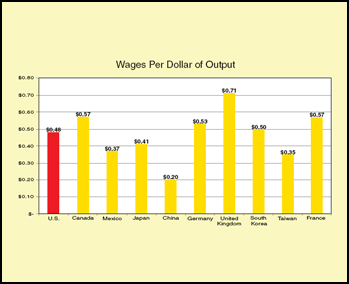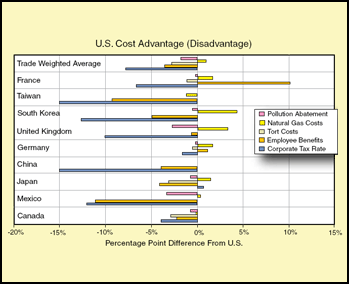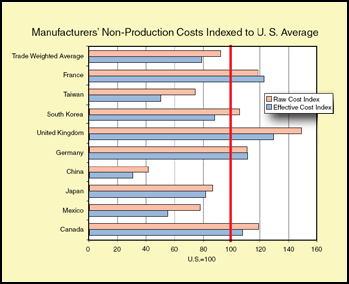| Well over 90% of U.S. exports are manufactured products. After several years of improvement in the cost structure of U.S. manufacturing, domestic producers are bracing for significant erosion in U.S. competitiveness due to cost increases largely outside their control. Not surprisingly, the federal government is a major influence on these external costs, either directly or indirectly. |
| |
| A recent study published jointly by the Manufacturing Institute and Manufacturers Alliance/MAPI examines the impact of corporate taxes, employee benefits, pollution abatement, energy costs and tort liability on the cost competitiveness of U.S. producers versus those in nine major industrial trading partners. |
| |
| U.S. wages per dollar of output, a measure which reflects not only wages but productivity, are $0.48, which compares favorably with five of the nine industrialized trading partners profiled in the research. Only Mexico, Japan, China and Taiwan had lower wages per dollar of output. |
| |
| But this strong showing by U.S. producers does not reflect the added costs of taxes, energy and other factors outside their control. The disadvantage imposed on U.S. manufacturers is illustrated in the nearby table, which quantifies the penalty to domestic producers in five areas: corporate taxes; employee benefits; tort costs; natural
gas costs; and pollution abatement. |
| |
| The biggest single cost disadvantage of U.S. manufacturers is in corporate tax liability. Only Japan has higher corporate tax rates, and most of the countries examined have rates far below the U.S. Aggregating all nine countries on a trade volume-weighted basis, the study estimates the penalty against U.S. producers is 7.8 percentage points. |
| |
| Countries without abundant natural gas resources suffer cost penalties versus the U.S., with South Korea, the United Kingdom, Germany, France and Japan
experiencing the greatest penalty. |
| |
 |
| [Place cursor over graph to enlarge] |
| |
| |
 |
| [Place cursor over graph to enlarge] |
| |
|
|
|
| The net impact of these five costs is seen in the chart. (See graph below.) The Raw Cost Index reflects only labor costs per dollar of output indexed to the U.S. (denoted
by the red vertical line). The Effective Cost Index adjusts the labor cost to reflect the cost impact of taxes, pollution controls, tort liability costs, natural gas costs and employee benefits. Again, this adjusted figure is indexed to the U.S. The mature economies of France, the United Kingdom, Germany and Canada have higher cost structures than the U.S., while the developing markets of Taiwan, South Korea, China and Mexico are significantly more cost competitive. |
| |
 |
| [Place cursor over graph to enlarge] |
| |
| Logic would say this is the expected outcome, but don’t forget that based on wages per dollar of output, the U.S. is pretty competitive with Mexico, Japan and Taiwan, and actually below South Korea. The competitive disadvantage is an imposed cost, most notably corporate taxes, over which manufacturers have little control. |
| |
| The political winds blow ill for U.S. producers in the international arena today, so expect the cost disadvantages to be magnified. |
| |
 |
The federal government has stymied attempts to develop domestic natural gas resources, and the mandates for expensive renewable energy and cap-and-trade will increase energy costs further. |
 |
Neither President Obama nor the Congress seems to have an appetite for reducing corporate taxes. Given the spending orgy that has seized Washington, taxes
are more likely to increase than go down. |
 |
After some headway on tort reform under the Bush administration, expect the trial bar to flex its political muscles and get some return on its campaign spending. Democrats received 76% of the $236 million contributed by lawyers in the 2008 election cycle. |
 |
Health care costs are ever increasing, but the Obama administration is not content with a market-driven solution. When the federal government gets
involved, expect even higher costs. |
|
 |
There is also some risk U.S. productivity gains will be eroded if the Employee Free Choice Act (EFCA) is passed, even in some watered-down form. Any legislation that leads to increased unionization or mandatory federal arbitration of labor contracts will ultimately raise costs and reduce productivity. |
| |
|